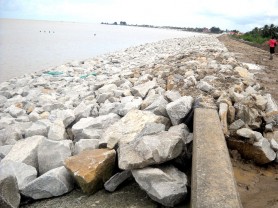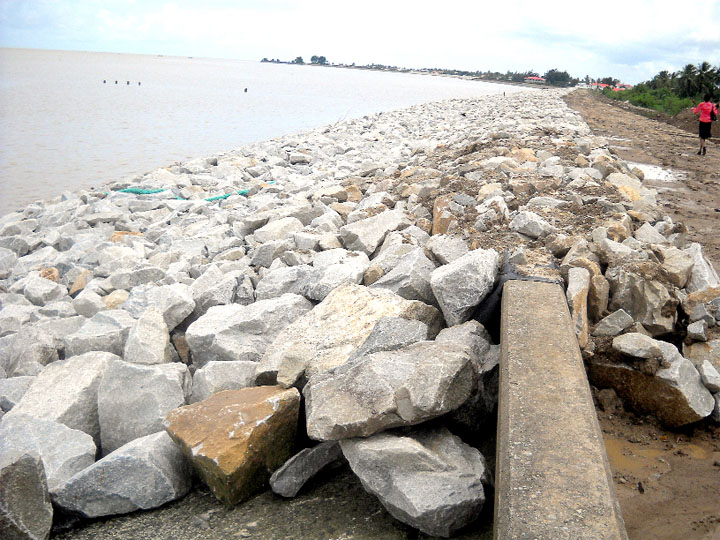– European-funded work 31% completed
As construction giant, BK International proceeds with multi-billion dollar sea defence work it has asked the authorities to review some projects where the designs are for mass concrete seawalls, arguing that the rip-rap design would be better.

BK, under the Ninth European Development Fund (EDF) Sea Defence Pro-gramme, is currently working on the reconstruction of 1.5 km and rehabilitation of 18 km of sea defences in different areas along the coast in a 13.6 million euros contract. The firm’s spokesman, Kit Nascimento said that under the project, several sites have been designed as ‘wave-wall’ or mass concrete seawall. In March, he said, BK wrote to the Finance Ministry and indicated its concerns about the ‘wave-wall’ design being used in preference to rip-rap because over the years, according to him, the wave-wall design “has been proved to be unsuccessful”.
The rip-rap design in-volves rocks or boulders being placed to protect shorelines or structures against erosion. It works by absorbing and deflecting the impact of a wave before the wave reaches the defended structure.
The Ministry has responded that it is confident in the designs but has changed some sites to rip-rap, while reviews are ongoing at nine sites, Nascimento said. Other sites remain wave-wall. The project encompasses 34 sites but not all are new work, with some involving repairing the sea defence. Work has started at 13 sites and overall, to date, 31% of the work has been completed. The project will conclude in October next year.
Taking reporters to view a recently completed rip-rap project at Stewartville, West Coast Demerara yesterday, officials of the construction firm emphasized that the rip-rap design is better than the ‘wave-wall’ design both in terms of cost and technical aspects. “As a responsible contractor we are identifying our concerns [to the ministry]”, Administrative Mana-ger at BK International Dayaljee Persaud said. He said in doing this, the company is fulfilling its responsibility but will go ahead with its contractual obligations if the ministry decides to stick with the original designs.
The work at Stewartville was done under the emergency sea defence project and involved constructing 550 metres of rip-rap sea defence. The work cost $221 million and was financed by the government. Construction started in April and was completed in September. The seawall here had been broken by high tides a few years ago.
Absorb
Stating that rip-rap is better, Acting Project Manager Dr Clifton Inniss explained that during the high-tide the boulders dissipate the energy of the waves and the waves do not rise as high as they would if the defence was a wave-wall. The size and mass of the boulders would absorb the impact energy of waves, while the gaps between the rocks trap and slow the flow of water, lessening its ability to erode soil or structures. The wave-wall would not dissipate as much energy because it is smooth. Additionally, he said, the force of the waves is spread over the longer length of the rip-rap but with the wave-wall being shorter, the pressure on the earth is greater with that design.
Inniss said rip-rap has several other advantages over wave-wall including that it is ‘flexible’ as opposed to the ‘rigid’ wave-wall. He said that with rip-rap, if there is a need, the height can be raised with simply the addition of more boulders while a ‘wave-wall’ would have to be built up. Where the heights of wave-walls have to be increased, a portion has to be removed and then built up. There would be concerns about the stability of the base and the ability of the wall to take the additional weight.
Further, he pointed out, in the rip-rap design there would be accretion of sand and silt and when this builds up, mangroves can grow giving additional protection to the shore. There is also a public aspect, where wave-walls have to be built higher than the rip-rap and persons would find it harder to get access to the sea. There can also be scouring of the base of the wave-wall which can undermine the wall.
On and on
Quizzed on the life span of the rip-rap design, Inniss said it just requires maintenance. He said that once this is done, the life span can go “on and on” and additional boulders can be added if necessary to raise the height. On the other hand, more construction would have to be done with wave-wall, he pointed out. Nascimento said that as a result of the concerns raised, the ministry has reviewed some designs and this is continuing. He cited Better Hope as one area where the design has been changed to rip-rap while reviews of nine other site designs are ongoing.
In an update on the works under the Sea Defence Programme, BK said that overall, the project is 31% completed. Under Lot One, at Springlands, work is completed on the demolition of the existing seawall and construction of 182.5 metres of rip rap and earthen embankment. At Clonbrook, work consists of the demolition of the existing seawall and the construction of 1,370 metres of rip-rap and earthen embankment. This is 70% completed.
In Lot Two at Kitty, work consisted of the placement of 4,500m3 of boulders between the Celina Restaurant and the Pegasus Hotel and this has been completed. At Montrose/Vryheid’s Lust/Better Hope, the work is 26% completed, with the mass concrete seawall originally designed for wave-wall being replaced by rip-rap. At Melanie Damishana, the work involving construction of 300 metres of new seawall of mass concrete, repair of 600 metres of cracks and joints and the placement of 1,100m3 of boulders along the toe and the construction of earthen embankment is 27% completed.
At La Bonne Intention, work involving construction of 375 metres of new seawall of mass concrete is 5% completed while at Chateau Margot, work on 225 metres of new seawall of mass concrete is 5% completed.
At Zeelandia in Wakenaam and Aurora, rip-rap works are completed while at Zeelugt, work on 553 metres of new seawall of mass concrete is 10% completed. At Greenwich Park, work on construction of 100 metres of new seawall of mass concrete is 3% completed while work at Johanna Cecilia and Lima involving rip-rap are 50% and 5% completed, respectively.

